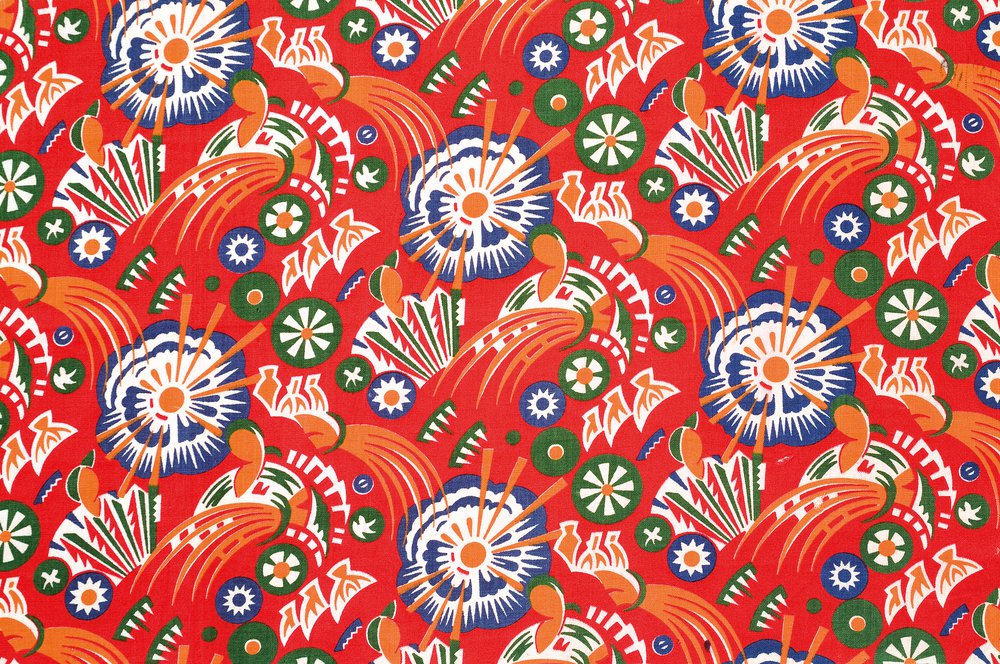The vanishing cloth of revolution

Chintz decorative "Village Komsomol." K. Shchuko. 1926–1928 Ivanovo-Voznesensky textile trust, cotton fabric, direct printing
The short-lived contribution of the Avant-Garde to Soviet textiles in an exhibition on the shores of the Pacific Ocean.
Only a Revolution could have inspired artists to design clothes for collective dinners, suits for lectures or festive outfits for demonstrations. In the Soviet Russia of the 1920s there was even serious talk of designing a tablecloth for public canteens with different options for the arrangement of dishes incorporated in the fabric’s pattern.
Almost all the masters of the Russian Avant-Garde made a contribution to shaping the new environment and the industry of mass consumption. “Artists, respond!” was the title of an article published in Pravda on 29 November 1923, which called upon creative artists to start “serving a substantial cross-section of the entire population of the USSR, creating new patterns for chintzes and new combinations of colours for fabrics.”
The artists Lyubov Popova (1889–1924) and Varvara Stepanova (1894–1958) enthusiastically responded to this call to action, signing up to work at Moscow’s First Cotton-Printing Factory. Even if working in industry meant that they had stop painting, the new geometry, ornaments, and patterns which these artists created with an emphasis on shape, line, and colour largely remained a continuation of the painting quests of the "Amazons of the Russian Avant-Garde," to which both belonged. “Chintz is just as much a product of artistic culture as a painting, and there is no reason to draw any kind of dividing line between them,” wrote the Russian Avant-Garde writer and art critic Osip Brik (1888–1945).
However, it wasn’t just artists who stayed behind in Soviet Russia who were forced by the Revolution to take up design in earnest. Sonia Delaunay (1885-1979), who was born in Ukraine but lived in Europe, found herself suddenly without the stable income she had previously received from her St. Petersburg family. Avant-Garde painting was no longer selling well. Sonia therefore opened a workshop to print fabrics carrying her own designs, including her famous coloured ornaments based on geometrical shapes.
Meanwhile in the Soviet Union, the abstract, object-less style, even if it was international, classless, and free of historical memory, soon faded away. Popova and Stepanova stopped working for industry. Textiles were now "weaponised" and used to promote campaigns for such public ideals as life on collective farms, sport, industrialisation and the spread of electrification. Five-pointed stars, the hammer and sickle, airplanes, airships, tractors and combine harvesters burst with self-assurance into a world of abstract ornaments which used to be printed on satin and chinz earlier.
The new products were given brutal-sounding names such as "Watersports," "Air squadron," "Our steam engine flies ahead," "The industrialization blanket," "Women in the East then and now," "(Achieve) the five-year plan in four years" and "Give the countryside balalaikas." Full of optimism, artists believed that the country had a bright future and textiles became a platform for a mass propaganda campaign that took the name of Agitprop.
The "100% Ivanovo" textile exhibition in the Arsenyev Primorsky State Museum in Vladivostok is part of the "Collecting Russia" project, which has for the last four years been bringing rare treasures to the city from Russia’s regional museums. This time, the exhibits are coming from the Burylin State Museum of Local History in the central Russian city of Ivanovo, a major textile manufacturing centre.
In addition to Soviet Agitprop textiles from the 1920s and 1930s, the exhibition will include materials from the 18th century all the way to the 20th. On show will be shawls, headscarves, printed calendars, textile "coupons," patterns, dyes, printing blocks and artists’ drawings created especially for fabrics.
A separate chapter in the project is the "Dmitry Burylin’s Room of Rare and Ancient Things," which tells the story of the founder of Ivanovo's textile production, a well-known patron and collector who gave his name to the museum.
Collecting Russia. 100% Ivanovo
Arsenyev Primorsky State Museum
Vladivostok, Russia
17 May – 30 September, 2019











